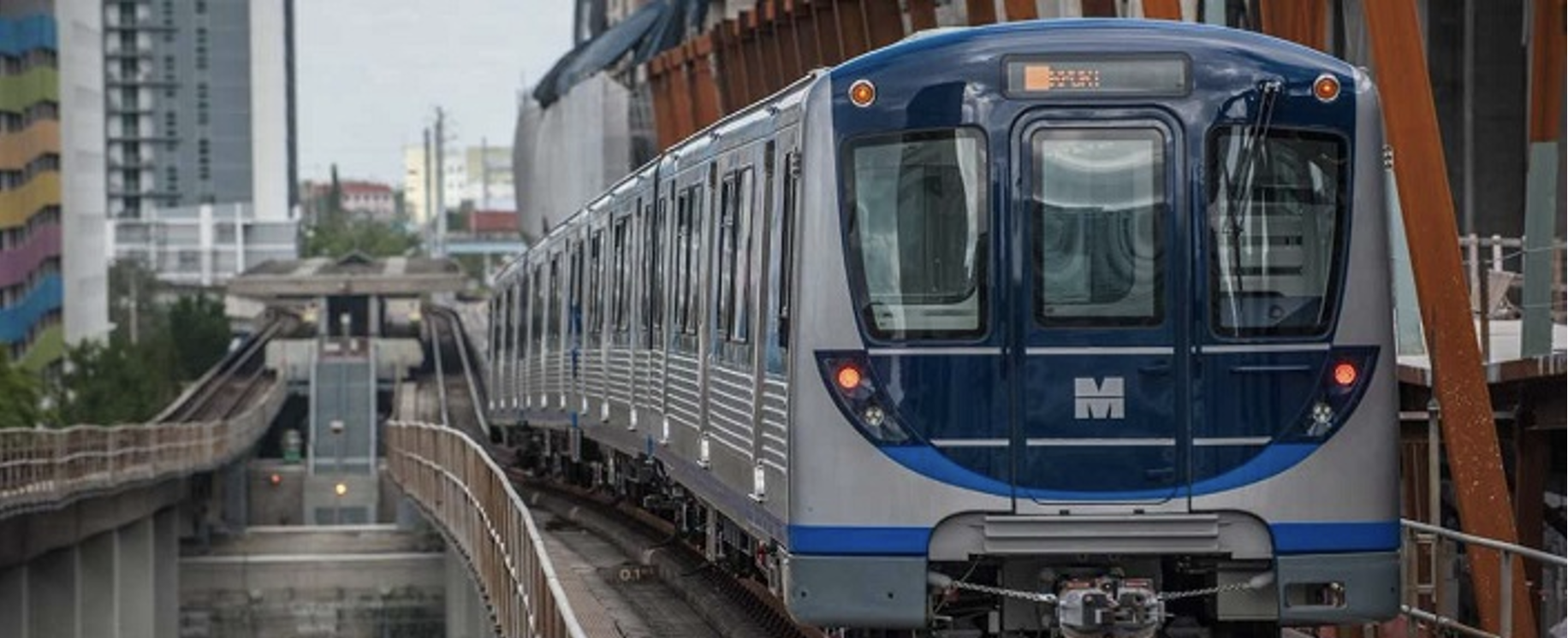General Summary
Our economy and transportation system are reliant on fossil fuels like coal, natural gas, and diesel. Fossil fuels are non-renewable resources that contain carbon and hydrogen that are burned for energy. They are derived from decomposed plant and animal matter that has been compressed beneath Earth’s crust for millions of years. As shown throughout the previous sections of my website, fossil fuels are directly linked to our air, food, and water systems.
Fossil fuels sustain our globalized society by providing energy for essential purposes such as water access, food preparation and activities such as offering heat and air conditioning to our houses. Moreover, any time anything such as people, water, cargo etc. are moved, energy is exerted and odds are, fossil fuels were used. Each fossil fuel has its own global warming potential which contributes to global warming as well as localized warm temperatures in cities.
Alternative Energy in Transportation
Renewable energy is an alternative form of fuel derived from natural sources. They are popular because they harness natural processes such as wind and water and convert those into usable energy. They regenerate at faster rates than fossil fuels, so they are often considered more sustainable. Examples of renewable energy sources are: 22
| Energy Type: | Source |
| Hydro | Captures the energy of water moving from high to low elevations |
| Solar | Harnesses the sun’s energy. This is the most abundant |
| Wind | The wind or kinetic energy of moving air by using large wind turbines located on land (onshore) or in sea- or freshwater (offshore) |
| Geothermal | Utilizes thermal (heat) energy underground reservoirs |
| Biofuel | Derived from organic materials like wood, charcoal, dung and other manures and combusted for energy |
The City of Miami, Florida has 927 public charging station ports for electric vehicles located about every 9 miles in the most populated areas – 224 stations in Miami are free which equates to 24% of stations. 927 charging stations are available with a fee. Fees may vary.15 View more information at charge hub.

Miami’s Transportation System
Navigating Miami can be difficult, especially if you’re visiting. As previously mentioned, in the Air Pollution and Climate section, Miami experiences extreme congestion on their roadways. This poses many sustainability challenges on the social, environmental and economic levels.
Listed are key transportation options in Miami. CLICK reveal specifics.
Miami’s Modes of transportation

Bikes – Personal and Private
- Residents can use bikes stored at their homes to get around.
- Private Bike Rentals are offered through Citi Bikes and small business rentals.
- City Bike is a solar-powered bike-sharing system which residents and visitors can rent.
- Prices: Membership Options are available. Visitors can rent bikes in half-hour increments.4
- half-hour ($5.75), hour ($7.95) or day ($24)
- Prices: Membership Options are available. Visitors can rent bikes in half-hour increments.4
- Those who use the service can unlock a bike from any station, ride it wherever (prohibited on the Metrorail or Metromover systems) and return the bike to any branded station.
- City Bike is a solar-powered bike-sharing system which residents and visitors can rent.

Metrobus 26 13
- Metrobuses are clean and air-conditioned buses that travel within the congested roads of Miami. Many residents and visitors opt out of using this system as schedules are unreliable.
- Frequency routes vary by time and day of the week.
- They often arrive every 10 or 15 minutes or every 45 minutes. It is hard to know as a resident.
- Prices: One-way bus fare: $2.25
- Free WiFi is also available.

Trolley 26
- Pictured is one of Miami Dade’s governmentally funded trolleys. It is free for all passengers to ride. Its operating route passes through Downtown, Brickell, Coconut Grove, Edgewater, Little Havana, Miami Beach, Wynwood and more.
- Hours: Weekdays and Saturdays 6:30am-11pm and Sundays 8am-8pm on most routes.
- Passengers can track the trolley live online

Metromover 26
- Picture below is the Metromover (left) and Metrorail (middle) Tri-Rale (right), the 3 main train lines of Miami-Dade.
- The Metromover is the smallest in the system with 21 stops and the most efficient and convenient.
- Price: Free
- Cars arrive every 90 seconds during rush hours & 3 minutes during off-peak hours
- The Metrorail is a 25-mile elevated train system that runs from Palmetto (north) to Dadeland (south) and stops about every mile.
- Price: A trip costs $2.25
- Free Wi-Fi on board
- The Tri-Rail is Miami’s largest rail system and is perfect for longer travels.
- Price: Fares range, depending on the trip. They range from $2.50 to $8.75 each way.
- View the metrorail system routes
- The Metromover is the smallest in the system with 21 stops and the most efficient and convenient.

Private Transportation 26
- The Brightline is a privately-owned inter-city rail that connects Downtown Miami to Orlando in around 3.5 hours.
- Ride-share apps: Such as Uber or Lyft.
- They are generally cheaper/quicker than taxis.
- Riders can customize their experience.
- With Lyft riders can share a car
- Uber has a Green, eco-friendly option, and a comfort (more legroom) option, plus up.
All these vehicles, other than the bikes, likely run on forms of diesel, gasoline, and natural gas. Miami is increasing the number of buses relying on renewable energy. Miami’s transportation office is working on having more than 550 renewable sources buses in their fleet.
Miami’s Sustainable Fleet
Miami-Dade County and the City of Miami are actively working on a sustainable transportation system. They are building up their sustainable transportation fleet by increasing the percentage of hybrids and biofuel powered vehicles. According to the U.S. Department of Energy, Miami-Dade County has the 3rd largest public hybrid fleet in the nation. 16 At the 16th Annual Green Fleet Awards, Miami-Dade County’s Internal Services Department (ISD) Fleet Management Division was recognized as the 4th best out of 100 ranked National Association of Fleet Administrators (NAFA). This is an improvement from the 2023 Green Fleet Award where Miami-Dade was ranked 11th. 17 Their hybrid electric vehicle fleet contributes about 500,000 gallons of gasoline emission reductions annually, which prevents more than 6,000 tons of GHG emissions from entering the atmosphere. 16
Miami-Dade County’s Mayor, Daniella Levine Cava viewed this recognition as a testament to the county’s “commitment to having a future-ready, sustainable fleet that meets the needs of [their] community and the environment”. As mentioned in the website’s introduction, part of Cava’s Climate Action Strategy is the improvement of the ISD’s Fleet Management Division. 16
Miami Dade County aims to 16
- Reach 100% ‘light fleet’ electrification by 2030.
- Formulate a centralized vehicle purchase and replacement system.
- Develop electric charging infrastructure for all kinds of vehicles.
- Enhance fuel standards and other key policies/ programs to achieve lower emission.
Miami-Dade is incentivized to shift to renewable power sources by the “Renewal Fuels Standard Credit” offered through the Environmental Protection Agency (EPA) that provides the county fuel cost savings.14
Miami’s Particular Challenges
Transportation in Miami is a complex issue, as many sustainability issues are. Transportation intersects with many other climate challenges; For example, many of the issues brought to light in the Water and Air Pollution sections pose similar challenges within transportation management. 17
For example:
Intense Heat due to the “Urban Heat Island Effect”
- As you may recall from the Air Pollution segment, global warming and the urban heat effect have significant public health, social and economic impacts on all ages of Miami-Dade’s population.
- It relates to transportation in two ways:
- The intense Miami heat poses a great risk to commuters walking on foot or cycling. Many don’t want to commute on foot for longer than 10 or 15 minutes due to the temperatures. 26 There is a lack of incentives in place to commute in these ways because there is a lack of infrastructure to support people commuting on foot or by cycle.
- Citizens are unable to arrive at work sweaty and smelly, however there are few options to shower and change at work. Expectations, especially in corporate environments, are that employees must arrive spotless and put together. This encourages the use of personal cars or sometimes public transport.
- The intense Miami heat poses a great risk to commuters walking on foot or cycling. Many don’t want to commute on foot for longer than 10 or 15 minutes due to the temperatures. 26 There is a lack of incentives in place to commute in these ways because there is a lack of infrastructure to support people commuting on foot or by cycle.
- There were very few results on the internet for public showers. According to yelp, the best public showers were at gyms, very far from many businesses. 21
- Additionally, Miami-Dade is historically known as being dangerous for pedestrians as it was identified as the fourth most dangerous metropolitan area in the US for pedestrians in 2016. Since then, the county has committed to increasing the walking & cycling infrastructure through redesigning the transit system to include better bus stops, more present bike lanes, and wide/ elevated sidewalks.
- This improvement is aimed particularly at eliminating traffic-related deaths and serious injuries by 2030, however not much investment has been expressed in shifting away from a car-dependent transit system.
- Additionally, Miami-Dade is historically known as being dangerous for pedestrians as it was identified as the fourth most dangerous metropolitan area in the US for pedestrians in 2016. Since then, the county has committed to increasing the walking & cycling infrastructure through redesigning the transit system to include better bus stops, more present bike lanes, and wide/ elevated sidewalks.
- GHG emissions from any form of vehicle transport, as covered in the Air Pollution section.
- GHG emissions exacerbate climate change and increase extreme heat weather events.
- Refer back to the sections, “Pollution[1] Created by Tourism, Transportation & Big Business Practices” “Sustainability[2] at Port Miami.”
- & more
- It relates to transportation in two ways:
Car-Dependency & Poor Urban Planning Reinforces Separation
Transportation is key to Miami as it was home to Henry Flagler, the creator of the Florida East Coast Railway (FECR), which spanned from Daytona to Key West, and shaped the topography and urban planning of the area. While it was destroyed in a storm, it laid the path for industries such as tourism and agriculture to grow exponentially. More specifically, Flagler and his good friend Henry Ford brought many people to Miami through their large-scale construction project of the FECR and a hotel. While this did wonders for the economy and subsequent growth of the area, this led to overwhelmed city systems, separation of society, the racist practice of redlining and more recently a dissociation of community unity within neighborhoods.
The social challenges associated with this development happened in Two instances:
During the construction of key transportation infrastructure
- Issues started with the construction of the FECR and neighboring hotels in the early 1900s. Flagler and Ford brought many immigrants and people of color to the Miami-Dade area to work on their construction projects.9 Despite bringing these individuals to the area, segregation issues persisted. Read more about specific issues here.
- The general creation of highways such as I-95 acted as a kind of redlining to separate certain communities from each other. 10
- When constructing I-95, over 12,000 Floridian residents were forcibly moved, many of which were Black individuals.
- In the 1960s, the government seized buildings across Overtown, the center of Miami’s Black community to build this highway
- Compensation for the inconvenience were well below the market rate.10
- In the 1960s, the government seized buildings across Overtown, the center of Miami’s Black community to build this highway
- When constructing I-95, over 12,000 Floridian residents were forcibly moved, many of which were Black individuals.
- Segregation10
- Many physical and invisible lines were drawn when developing our systems to keep Black and white communities in an attempt to separate those with varying levels of socioeconomic statuses.
- Physical: The development of our train system, interstate highways, buildings, fences, fields, etc.
- Within Miami, the “color line” was created by Henry Flager’s FECR and expanded by the construction of I-95
- Non-physical: Redlining practices were likely unlawfully occurring. This is when certain neighborhoods are purposely excluded through forms of monetarily pricing them out, withholding essential services (such as grocery stores creating a food desert, withholding healthcare, ect.) and more.
- Housing affordability, poverty & food deserts 10
- As a result of redlining and segregation many neighborhoods with BIPOC populations, or those who identify as Black, indigenous, and other people of color, either got priced out or were ineligible for essential services.
- The creation of I-95 decimated the population of Overtown, starting from ~50,000 and dropping ~10,000.
- Many physical and invisible lines were drawn when developing our systems to keep Black and white communities in an attempt to separate those with varying levels of socioeconomic statuses.
- The general creation of highways such as I-95 acted as a kind of redlining to separate certain communities from each other. 10
Current Day

- Cookie cutter houses and segmented neighborhoods like the one pictured above leads to… 6
- A lack of affordable housing
- Less economically productive communities
- They disincentivize people supporting local businesses
- Why?
- Less community interaction
- Individual ways to get commute
- Fosters the use of online shopping services like Amazon since neighborhoods and businesses are in separate spaces
- Lack of incentive to shop local, lack of access to necessary amenities and services, such as schools, hospitals, and parks
- A reduced human interaction and community development
- Supports individualistic behaviors & ideals within communities
- Why?
- They disincentivize people supporting local businesses
The Cruising & Cargo Shipping Community
Cruising is key to Miami’s economic success as it brings an influx of goods, people and revenue into Miami-Dade County; however, a key habitat and essential resource for Miami is Biscayne Bay and mangrove habitats. The bay receives high levels of pollution due to the frequent passage of boats and pipe spills. Pollution can be created through everyday usage, crashes or random leaks. 5
Read more about specific instances:
- Sewage Pipeline Leak:
- March 1, 2024
- November 13, 2020
- Views incidents from the 1980s
- Boat Collisions:
- Marine Pollution
- & More
Extraction of Natural Resources & Habitat Loss
Fossil fuels like crude oil are extracted from beneath the earth to power our whole lives. Our transportation is extremely reliant on fossil fuels which leads to them being extracted in unsustainable ways. Much of this occurs in or near the Gulf of Mexico, which isn’t too far from Miami’s waters and coast.
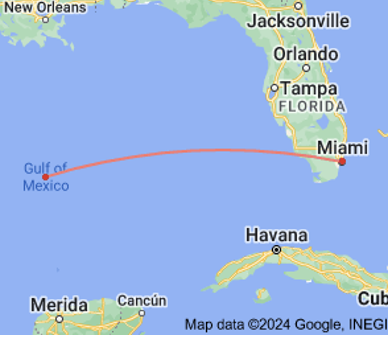
View the distance between Miami and the Gulf of Mexico above. The city of Miami is located less than 1,000 miles away from the center of the Gulf of Mexico and their water is part of the same system.
Gulf of Mexico’s Oil Spills

Boats at the BP’s Deepwater Horizon Oil Rig attempting to control the fire.
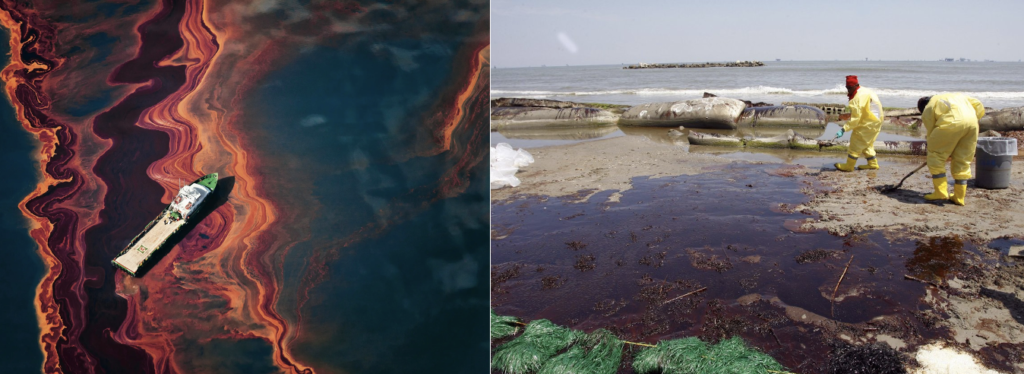
Major incidents documented in the Gulf of Mexico: 4 major oil spills
- In 1979, the Exploratory well IXTOC 1 spilled into Mexico’s Bay of Campeche in the Gulf of Mexico, 600 miles south of Texas. The spill took nine months to stop and released a total of 140 million gallons of oil into the Gulf of Mexico (x14 as much oil as the Exxon Valdez spill in 1989)
- In 1990, The Mega Borg spilled 5.1 million gallons of oil in the Gulf of Mexico leading to water contamination, fire and explosions
- In 2005, because of the harmful Hurricane Katrina, the U.S. Coast Guard estimated that over 7 million gallons of oil were spilled in the Gulf of Mexico by onshore and nonpoint source areas.
- April 20, 2010, the infamous BP Deepwater Horizon oil spill occurred right off the coast of the United States. It was the second largest oil spill in history and devastated both human and environmental communities. Over 206 million tons of oil spewed into the water when the semi-submersible oil rig had an explosion and caught fire. It sank on April 22 when automatic and manual efforts failed to fix the various problems. 2711
- Learn more about this here:
- https://ocean.si.edu/conservation/gulf-oil-spill/milestones
- Please note this link may be graphic for some viewers. https://www.nationalgeographic.com/animals/article/how-is-wildlife-doing-now–ten-years-after-the-deepwater-horizon
The Connection Between Habitats and Transportation
Habitats and transportation are more related than it seems. All habitats protect our roads and highways from being impacted by extreme weather events or even the effect of habitat destruction. Whether it is through counteracting climate change, shoreline stabilization, buffer zones for ocean waves/ wind or maintaining habitat equilibrium, natural spaces are key to keeping our transportation system regulated. With the increased possibilities of severe weather events, working with nature will be pivotal for the success of our societies in facing the climate crisis. This is where key solutions come into play.
Relevant Stakeholders:
Governmental
- Miami-Dade County Government – the following departments should be in collaboration…
- Strategic Procurement would bring a good perspective into how to acquire the resources and EV infrastructure to make meaningful impacts
- Transportation and Public Works
- & the surrounding counties: Broward Palm Beach, Florida Keys and the Glades interior counties
- Finance Department
- Florida Department of Environmental Protection
- United States Coast Guard
- Florida Department of Transportation
Institutions
- Residents of Miami
- Greater Miami Convention & Visitors Bureau is in charge of tourism. Any changes in the transportation sector will likely affect their operations.
- IBM Sustainability Accelerator
- Local collage’s students and faculty (University of Miami etc.)
Community
& more
Solutions:
Strong Urban Planning
The most prominent solution, with added social and physical value is implementing strong urban planning. In this city it would look like implementing walking & cycling infrastructure across the county.
Strong urban would have impacts such as…
- Increased time outside which has proven positive impacts on human mental health
- Less street congestion
- Less GHG emissions associated with transportation
- Would expose commuters to new business (if on foot)
- Create a stronger sense of community
- Encourage people to be active
- & more
What is urban planning?
Urban Planning is one of the most powerful tools in reducing car dependency and increasing urban value. It pertains to rethinking cities to lay a better blueprint for them to meet the needs of their citizens in a socially, environmentally and economically sustainable way. It challenges designers to consider the effectiveness of their current system and adapt them to achieve higher rates of effectiveness. 25
The 15-minute City Concept
This is what much of the highly developed world looks like…
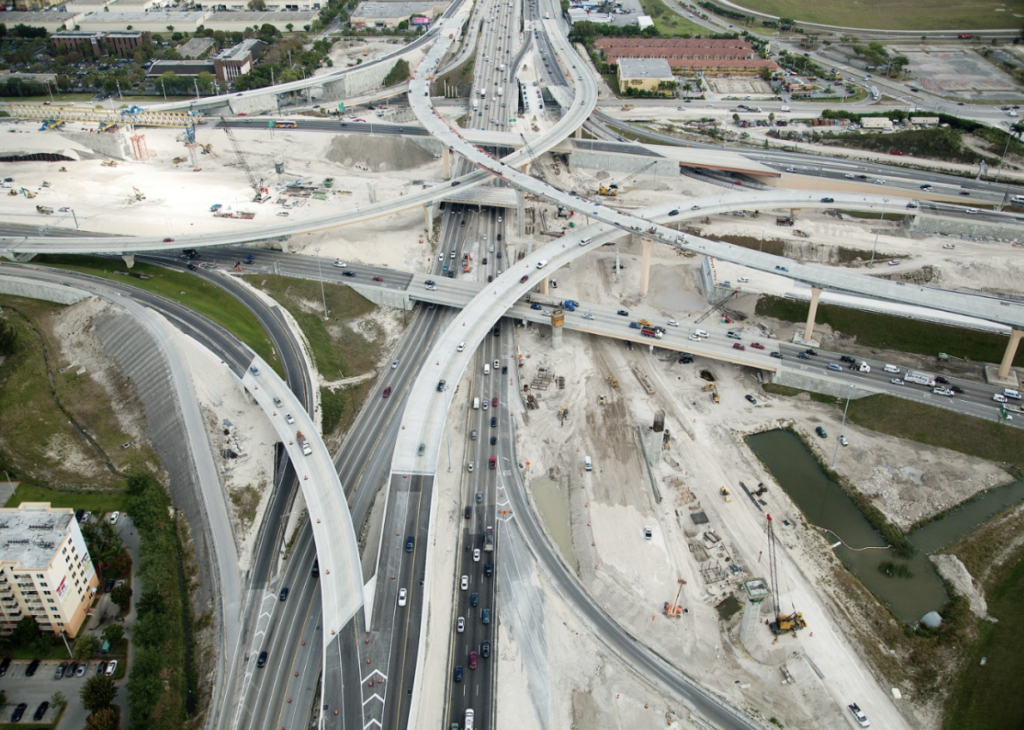
Miami, FL 12
Notice the car dependent infrastructure?…
Many global cities are designed in a way that heavily promotes vehicle transportation. Most specifically, this has been a defining aspect of American culture. We can see evidence of car dependency all across the US, in both urban and rural areas. 18
Car Dependency Key Facts 18
- About 80 percent of drivers feel they have “no choice” but to use cars due to their community’s transportation infrastructure
- “On average, transportation is often the second-largest household expense after housing (excluding healthcare).”
- Those with lower incomes spend high proportions of their budgets on transportation which can equate to more than quarter of a household budget.
- Communities of color are often further burdened with higher transportation costs compared to white communities with similar risks.
- Electric vehicles (EVs) can reduce some of the costs of car ownership, saving owners money on fueling and maintenance costs compared to equivalent gas-powered cars.
Many cities are reimagining the systems within their cities to provide a more functionable community for citizens to live, work and explore. They are achieving this by becoming a 15-minute city.
What is a 15-minute City
A 15 minute city is an urban design concept which ensures that all inhabitants are a 15 minute walk or cycle to the resources needed to fulfill all daily activities. This concept has been proven to have tremendous impacts on cities around the world. Cities have fully integrated 15 minute city principles and also implemented key ideas from the ideology to result in real social, economic and environmental change. 7 8

Click the image above to play the video.
Explore the positives and negatives of this approach
Positives 7 8
- Encourages people to exercise which makes citizens happier, healthier and more resilient
- Cuts down on unnecessary commutes & shortens worker’s days.
- Leads to healthier citizens and better neighborhoods with local businesses, shops, childcare facilities, arts venues and leisure amenities.
- Less transportation traffic leads to reduced GHG emissions
- Incorporating principles can eliminate food deserts, expand government services and supporting education systems
- Creates more high-traffic areas where commercial and cultural amenities can be created
One negative of the 15 minute concept is the results of the process of creative destruction. This happened within the transportation business as taxi cabs and public transport got replaced by options like Uber and Lyft. This shift in transport styles will harm many monetarily. 7
Let’s take Amsterdam as an example…
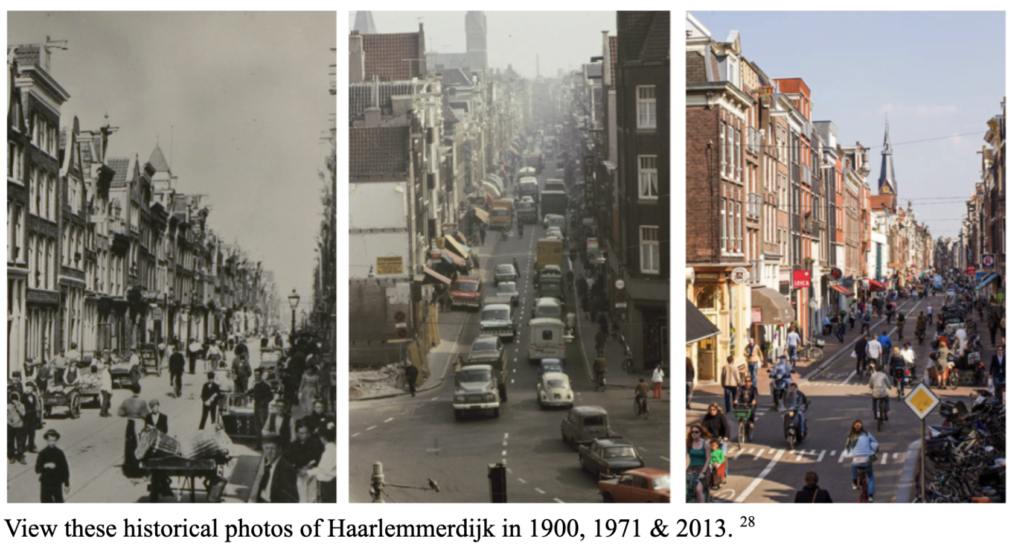
Amsterdam is the quintessential 15-minute city – as shown in the images above, you can see the transition from a car reliant community to a flourishing city that supports pedestrians. The shift to this setup wasn’t easy. In the 1980s, Amsterdam had a population boom which led to unsustainable development. There was very little space left in the landfills, all of the city’s systems were outdated and the society couldn’t sustain the growth with the current systems in place. Dedicated citizens of Amsterdam realized this and advocated for better urban planning initiatives that pushed their political leaders to make a much needed shift towards a more walkable, bikeable and public transportable city. This social response translated into tangible governmental action to account for and adapt for growth projections. Amsterdam became a 15-minute city as a result. 28
This process took decades; however, the activists were able to successfully make strides for more sustainable urban communities. This story and those similar are empowering to many cities around the world.
Some additional aspects of urban planning that should be considered are:
Multimodal Access
This term involves the transportation of people or goods from one destination to another through using multiple forms of transportation.19 (e.g. walking, biking, transit, rail, rideshares, etc.) This requires urban planners to ensure residents have vast affordable ways to travel. This solution is best implemented with regional collaboration.
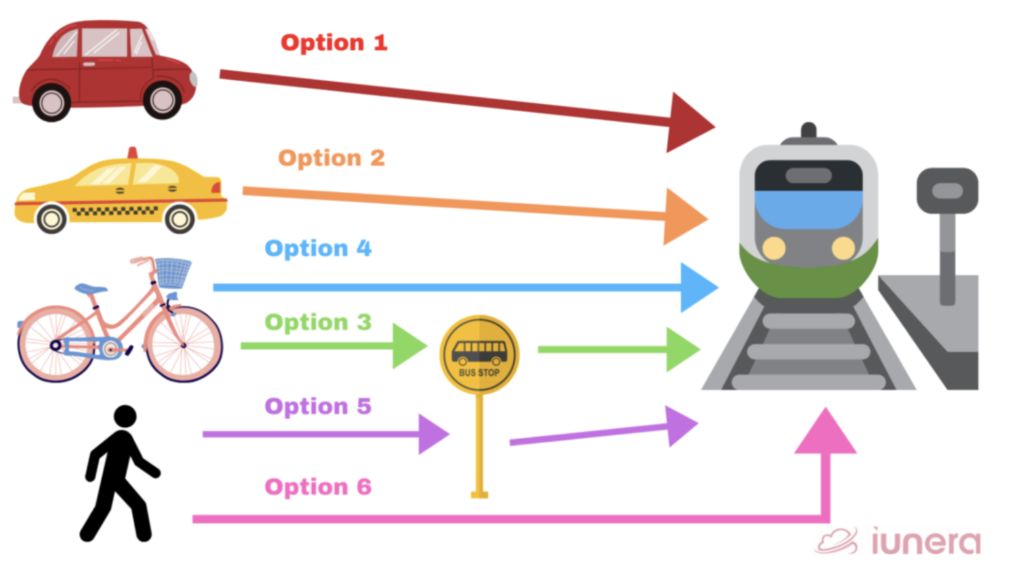
Sharing Economy
The sharing economy is a way to rethink our transportation system to be more collaborative and resource efficient. It is defined as when assets and services are shared to meet the transportation demands of people and goods.
- This happens on the local and private level
- I.e. Public bus, train, Carpooling, City Bike Program, Rideshare, Uber & Lyft, Carpool Lanes (high occupancy vehicle lanes) 19
When you think about it, during the advent of electricity, our power needs were simple. Each household and municipality had small energy demands, which is how our energy system was designed, with a limited capacity. Now, our energy and transportation system has stayed very similar, but societies have needed to adapt with the growing energy needs due to hyper consumption and growing populations. It is not shocking that our systems are overwhelmed and unsustainable. 24
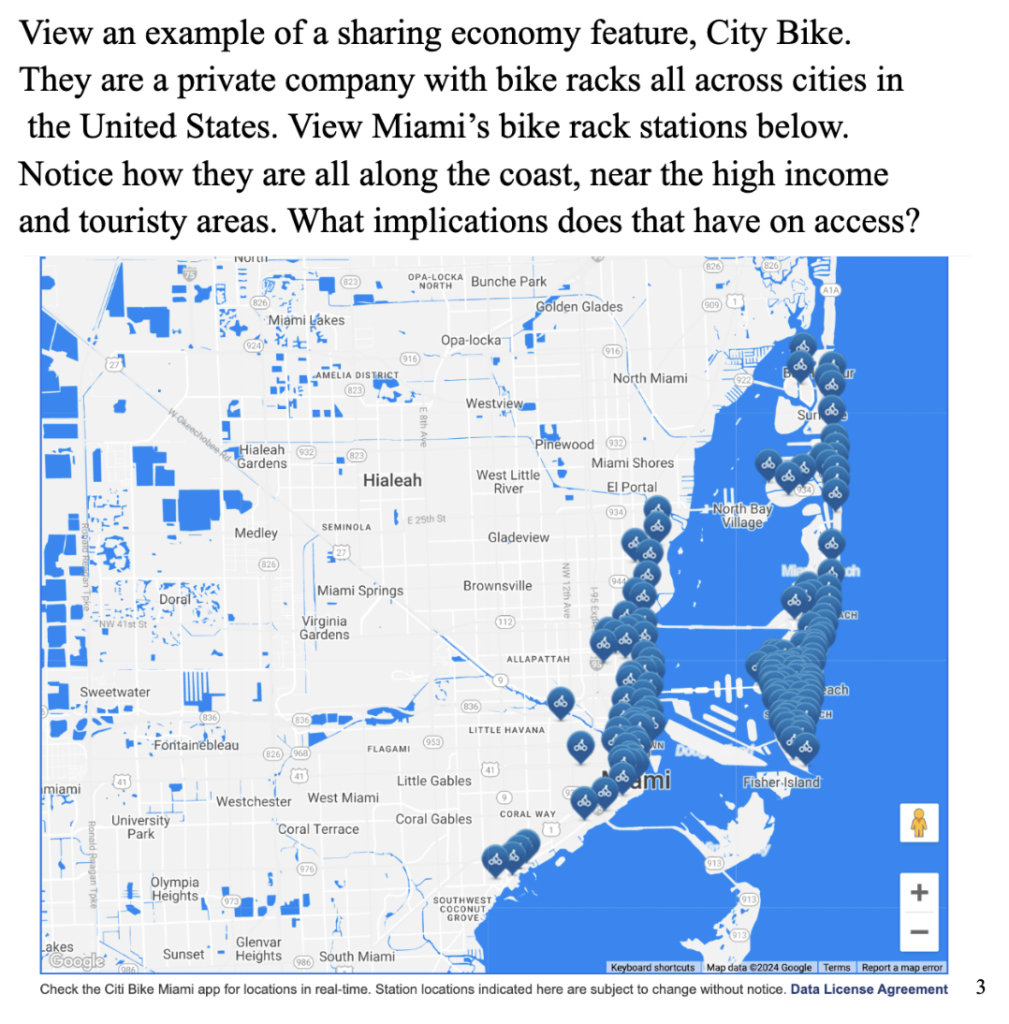
Electric Vehicles (EV)
Our globe has been shifting to electric vehicles as they have a higher fuel efficiency than internal combustion vehicles as well as they require fewer fossil fuels and natural resources to run, meaning they cut GHG emissions!
How they work: They use rechargeable lithium-ion batteries to convert energy to movement with an electric motor. Full EV’s require recharging typically at charging stations. Charging stations can be public with a charge or EV owners can invest in a personal power station.
- Hybrid EV’s use a combination of smaller batteries and gasoline to convert energy to movement. Although they use less resources, they are still using precious metals. Not all hybrids are plug-ins.
Learn why people are purchasing electric cars
Positives 2
- High energy efficiency
- EV batteries convert ~59% – 62% of energy to movement
- Gas-powered: ~17% – 21%
- Reduce GHG emissions
- Rechargeable battery
- Emissions associated with car creation is overlooked
- Require lower maintenance
- No oil change, etc.
- All types of renewable energy can be captured to enhance the sustainability of the electricity grid.
Negatives
- Non-renewable resources such as precious metals are used within the creation of the cars. Specifically, the batteries use precious metals such as lithium, cobalt, manganese, nickel, and graphite. These are all non-renewable resources.
- This generates geopolitical & social problems
- Ex. Mining the Ocean
- This generates geopolitical & social problems
- Lack of charging infrastructure
- Rural & Urban (accessibility)
- Limited travel capabilities
- Geographically & distance
- EV → 60 and 120 miles per charge
- Gas → ~300 miles (full tank)
- Geographically & distance
- Long “Fueling” times (up to 8 hrs)
- Many can be priced out in terms of purchasing & refueling the car
More info on Working with Nature, Not Against It
View these links to learn more about how societies can harness nature’s abilities and systems to improve our communities.
- https://www.planetizen.com/news/2023/03/122185-working-nature-not-against-it
- https://www.miamidade.gov/global/government/mayor/state-of-the-county/2024/home.page
- https://www.miamidade.gov/global/transportation/home.page
View Maimi’s Current Solutions, Programs and Initiatives:
View Miami-Dade’s: Asset Management Plan
Limitations/Barriers Related to These Initiative
- Climate change and increasing global temperatures make more sustainable modes of transportation such as biking, walking and multimodal approaches inconvenient and unreasonable.
- Pedestrian-friendly roadways are possible however in Miami, the expectation is that citizens do not commute on foot for longer than 10 or 15 minutes.
- The economic barriers in terms of the price to sustain, purchase and rent EVs are substantial. This does not make the solution viable to be implemented in general.
- Infrastructure, Institutional, and Cultural Barriers
- EV, renewable and urban planning infrastructure are not currently implemented in our cities and rural areas. They are needed in order to support all of the solutions mentioned. This requires sufficient upfront costs, institutional buy-in and a societal/ cultural shift which is not guaranteed to occur across the world.
- Equity Concerns
- There is unequal access to solutions in terms of infrastructure and expenses.
- Government Subsidies Favor Fossil Fuels
- Fossil fuel companies have a stake in politics.
- Companies advocate for harmful regulation in terms of environmental degradation and safety standards.
- Governor of Florida, Ron DeSantis signed legislation taking clean energy decisions away from local governments.
- This disempowers local communities to make change and imposes more hoops for local governments to jump through. 23
- Governor of Florida, Ron DeSantis signed legislation taking clean energy decisions away from local governments.
- Lack of accountability with public transportation, public transport systems are unreliable, disincentivizing people to use them. 26
Conclusions
It is key to the definition of sustainability, that is leveraged in this examination of Miami, that the actions and impacts encompassed within their climate solutions meet the needs of present and future generations while staying within our planetary boundaries. This includes maximizing renewal periods and protecting/ restoring the health of natural systems.
Miami-Dade County has a commitment to enhancing the standard of well-being for those within the city in the short-term but can improve on their ability to support their long-term residents in their daily transportation needs. The county is focusing on land use, however their evident emphasis is infrastructure and fleet improvement in certain urban areas, like center city. Less touristy areas are not being impacted by county initiatives leading to a lack of enhancement in county-wide commuting experience. With solutions, as our class identified, it is important to enact ethical economic development, which is not occurring in Miami. The focus on fleet electrification and solutions which support car dependent infrastructure means that Miami has a long way to go to have a sustainable transportation system. Investing in solutions such as EVs are a temporary solution, however the re-imagining of systems and spaces is a generally sustainable way to create added value socially, physically, economically, and environmentally.
Broad List of Assets
- Department of Public Works
- Miami Airport
- Miami Cruise Port
- Miami’s Infrastructure
- Pedestrian Walkways
- Bike Paths
- Metrobuses
- Accessible (ADA) Transit Services
- Transit Pass
- Special Transportation Service STS
- Exessaride
- SHIFT305 innovative strategy
- Note: There are no walking trails which are specifically designed to aid in better and more effective cycling and walking transport. All walking trails focused on exercise.
